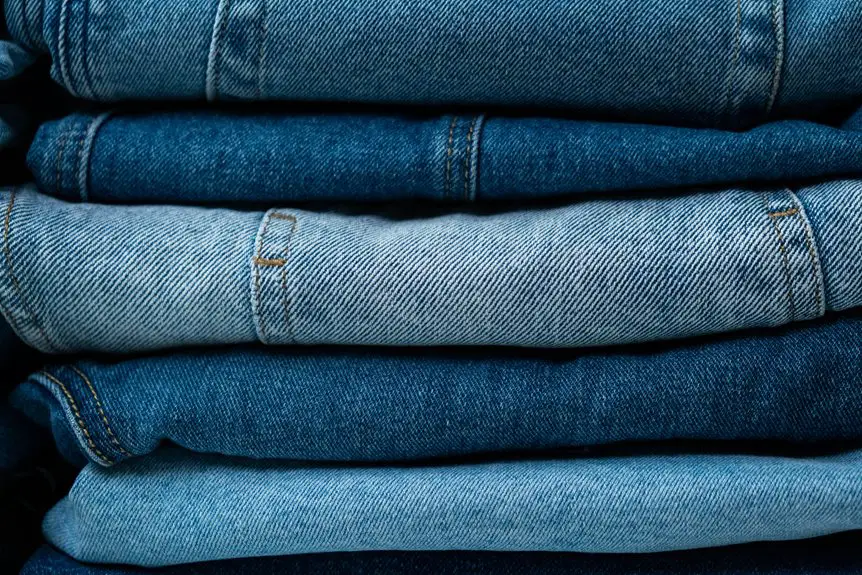Your black clothing might be bleeding dye due to several factors. The type of dye used can affect colorfastness, while hot water can loosen dye bonds. Mixing darker items with lighter ones also leads to colors transferring. To fix this issue, wash in cold water and separate laundry loads. You can also use color fixatives and gentle detergents designed for dark fabrics. Discovering more effective strategies can help you keep your blacks looking vibrant longer.
Table of Contents
Key Takeaways
- Black clothing may bleed dye due to the type of dye used, which can easily release color during washing.
- Washing in hot water loosens dye bonds, increasing the risk of color bleeding; cold water is recommended to prevent this.
- Mixing dark clothes with lighter items can lead to color transfer; always separate laundry loads to avoid this issue.
- Excessive detergent use can strip color from fabrics, contributing to dye bleeding; use gentle detergents specifically for dark colors instead.
- To fix bleeding, use color fixatives or soak garments in a vinegar solution to stabilize the dye before washing.
Causes of Dye Bleeding in Black Clothing
When you wash black clothing, you might notice dye bleeding, and this can happen for several reasons.
Washing black clothing can lead to dye bleeding due to various factors, including dye type and washing conditions.
One major cause is the type of dye used during the fabric’s manufacturing process. Some dyes are less colorfast, meaning they release color more easily when exposed to water.
Additionally, washing in hot water can exacerbate dye bleeding, as heat can loosen the dye bonds in the fabric.
If you mix black clothes with lighter items, the darker dye can transfer, especially if the lighter fabrics aren’t colorfast.
Finally, wearing your black clothing often can lead to fading, which may increase the likelihood of dye bleeding during washes.
Taking these factors into account can help you understand why your black clothing bleeds dye.
Common Mistakes That Lead to Dye Bleeding
Although you might think you’re taking good care of your black clothing, some common mistakes can lead to dye bleeding. One major error is washing dark clothes with lighter items, which can cause color transfer.
You may also be using too much detergent, which can strip away color. Ignoring care labels is another mistake; they often provide essential guidance on washing temperatures and drying methods.
Additionally, drying your clothes in direct sunlight can fade the dye and cause bleeding. Finally, skipping the pre-wash test for new garments can lead to surprises when you wash them for the first time.
Effective Prevention Strategies
To keep your black clothing looking sharp, wash them in cold water.
Always separate laundry loads to prevent any dye transfer.
These simple strategies can save your favorite pieces from fading and bleeding.
Cold Water Washing
Washing your black clothing in cold water can considerably reduce the risk of dye bleeding. Cold water helps to set the dye, preventing it from loosening and transferring onto other garments.
Here are a few tips to make cold water washing even more effective:
- Use a gentle detergent: Opt for detergents specifically designed for dark colors.
- Avoid fabric softeners: These can interfere with dye retention and may cause fading.
- Wash inside out: Turning your clothes inside out can minimize friction and protect the outer layer.
- Don’t overload your washer: Give your clothes enough space to move around freely, ensuring a thorough clean without excess agitation.
Separate Laundry Loads
When you separate your laundry loads, you greatly decrease the likelihood of dye bleeding onto other garments. By organizing your clothes, you can protect your favorite black items from unwanted color transfer. Here’s a simple guide to help you sort your laundry effectively:
| Load Type | Color Code | Suggested Temperature |
|---|---|---|
| Dark Clothes | Black, Navy | Cold |
| Bright Colors | Red, Yellow | Cold or Warm |
| Whites | White | Hot |
| Delicates | Pastels | Cold |
Treatment Methods for Dye Bleeding
One effective way to treat dye bleeding in black clothing is by using a color fixative. These products help stabilize the dye, reducing the risk of future bleeding.
Here are some methods you can try:
- Vinegar rinse: Add a cup of white vinegar to the wash cycle to help set the dye.
- Salt soak: Soak your black clothing in a solution of water and salt before washing.
- Cold water wash: Always use cold water to prevent the dye from loosening and bleeding.
- Commercial dye fixative: Look for a product specifically designed for fabric dyeing to help lock in colors.
Choosing the Right Dye for Your Fabrics
When it comes to dyeing your fabrics, choosing the right dye can make all the difference.
Fiber-reactive dyes are often a great choice because they bond well with the fibers, ensuring vibrant and long-lasting colors.
Fiber-Reactive Dye Benefits
Choosing the right dye for your fabrics can make a significant difference in both the vibrancy and durability of your clothing. Fiber-reactive dyes are an excellent choice for achieving rich, long-lasting colors. They bond chemically with the fibers, ensuring that the dye doesn’t wash out easily.
Here are some benefits of using fiber-reactive dyes:
- Vibrant Colors: These dyes produce bright, intense shades that won’t fade quickly.
- Wash Fastness: They resist bleeding and fading, even after multiple washes.
- Versatility: Suitable for a variety of fabrics like cotton, linen, and rayon.
- Eco-Friendly Options: Many fiber-reactive dyes are low-impact and less harmful to the environment.
Quality Dye Importance
The right dye can make all the difference in how your fabrics look and feel over time. When choosing a dye, consider its quality and suitability for your specific fabric type. High-quality dyes not only enhance color vibrancy but also improve wash and fade resistance.
| Quality Dye Features | Benefits |
|---|---|
| Deep Color Saturation | Longer-lasting vibrancy |
| Wash Fastness | Resists bleeding and fading |
| Fabric Compatibility | Adheres well to fibers |
Investing in quality dye guarantees your black clothing maintains its rich hue and texture. It’s worth taking the time to research and select the right product to avoid frustration later on. You’ll appreciate the results in your wardrobe!
Fabric-Specific Dye Selection
Selecting the right dye for your fabrics is essential to achieving ideal color retention and performance.
Different materials absorb dye differently, which can affect how your black clothing looks over time.
Here’s what you should consider when choosing your dye:
- Cotton: Use fiber-reactive dyes for vibrant colors that last.
- Polyester: Opt for disperse dyes, as they bond better with synthetic fibers.
- Wool: Acid dyes work best, providing rich hues and good wash fastness.
- Silk: Choose acid dyes as well, ensuring a luxurious finish with minimal bleeding.
Long-Term Care Tips for Maintaining Black Clothing
While black clothing can add a sleek touch to your wardrobe, it requires special care to keep it looking vibrant.
Start by washing your black clothes in cold water to prevent dye bleeding. Always turn them inside out to minimize friction and fading. Use a gentle detergent designed for dark colors to maintain their richness. Avoid bleach and fabric softeners, as these can strip the color.
When drying, opt for air drying or a low heat setting; high heat can cause fading. Store your black garments in a cool, dark place, away from direct sunlight.
Finally, consider using a fabric spray or color fixative occasionally to enhance and preserve the deep black hue. With these tips, your black clothing will stay sharp and stylish.
Frequently Asked Questions
Can Fabric Softeners Contribute to Dye Bleeding in Black Clothing?
Yes, fabric softeners can contribute to dye bleeding in black clothing. They often contain chemicals that break down fibers, which may release dye. It’s best to avoid using them on dark fabrics to preserve color.
How Can I Identify if a Fabric Is Colorfast?
To identify if a fabric’s colorfast, you can perform a simple test. Dampen a hidden area, then rub it with a white cloth. If color transfers, it isn’t colorfast, and you should wash it separately.
Is It Safe to Use Vinegar to Set Dyes?
Yes, it’s safe to use vinegar to set dyes. Just mix equal parts vinegar and water, soak your fabric, then rinse. This method can help enhance color retention, keeping your clothes vibrant longer.
What Should I Do if Colors Bleed Onto White Clothing?
If colors bleed onto your white clothing, act quickly! Rinse the affected area with cold water, apply a stain remover, and wash separately. Avoid using hot water or drying it until you’re sure the stain’s gone.
Can Repeated Washing Lead to Permanent Dye Loss?
If you keep washing your clothes like it’s the ’90s, you might notice permanent dye loss. Over time, detergents and hot water can fade colors, so try washing in cold water and air drying instead.
- What Is Acetate Fabric? Everything You Need to Know - June 24, 2025
- Beyond the Gown: 5 Unexpected Uses for Duchess Satin Fabric - June 24, 2025
- Duchess Satin for Structured Silhouettes: A-Line Gowns, Skirts, and More - June 24, 2025







